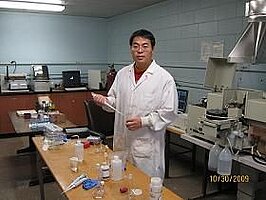Development of GAC-Fe Adsorbent for Arsenic Removal from Drinking Water

Qigang Chang is a Ph.D student in Environmental and Conservation Science Program at North Dakota State University. He received a Master of Science (2006) and a Bachelor Degree (2001) in Environmental Engineering from East China University of Science & Technology (ECUST), China. Currently, he is working on the project “development of GAC-Fe for arsenic removal from drinking water”.
Email: qigang.chang@ndsu.edu
Phone: 701-231-8955
Fellow: Qigan Chang
Advisor: Dr. Wei Lin, Ph.D., Associate Professor, Department of Civil Engineering, North Dakota State University
Degree Progress: Ph.D. in Environmental Science expected in September 2010
Development of GAC-Fe Adsorbent for Arsenic Removal from Drinking Water
Background:
From the 1890s to 1940s, arsenic-laced bait was used extensively throughout North Dakota to combat grasshopper infestations. The bait, which included arsenic trioxide, sodium arsenate, Paris Green and other arsenic compounds, was commonly applied to farm fields. Unused materials were often buried or dumped in pits and low-lying areas. Groundwater was heavily contaminated with arsenic. A superfund site, located in parts of Ransom, Richland, and Sargent counties, was approved in 1983. Intensive remedy efforts were taken, and in 1996, this site was removed from the National Priority List. On January 22, 2001, the USEPA revised the maximum contaminant level (MCL) of arsenic downward from 50µg/L to 10µg/L. All the remedy facilities in this former superfund site are no longer able to protect people’s health under the new MCL of arsenic.
Western North Dakota also has elevated arsenic in groundwater. The arsenic level is approximately 24µg/L in all three wells supplying drinking water at Oakes and is around 40µg/L at Devils Lake. The new regulation presents a major compliance challenge to the existing water supply systems, especially the small rural community systems that until recently had few regulation requirements. Some small communities are attempting to apply for regulatory exemptions due to the high costs associated with meeting the new MCL. While exemptions offer temporary cost savings, they do not defend the population from possible negative health impacts. There is an urgent need to develop safe and affordable technologies to meet the new drinking water standard in small rural communities in North Dakota.
Granular Activated Carbon (GAC) is an excellent stable adsorbent widely used in water treatment process, especially for organic contaminants. But GAC alone only exhibits limited adsorption capacity to arsenic. Research found that arsenic adsorption capacity increases significantly after activated carbon is impregnated with iron. However, the challenge is still present that how to impregnate GAC with more iron that evenly distributes to achieve a high arsenic adsorption capacity.
Objective:
The goal of this research is to develop GAC-Fe adsorbent to remove arsenic from drinking water to meet current stringent standard at an affordable cost for small rural communities in North Dakota.
Progress:
Synthesis of GAC-Fe
In 2008, a new iron impregnation method was developed and GAC-Fe adsorbents with different iron contents were synthesized. Scanning Electron Microscope (SEM), Energy Dispersive X-Ray Scope (EDS), and X-Ray Diffraction (XRD) were used to characterize GAC-Fe adsorbents in terms of distribution, morphology, and species of iron. Three different methods were compared as to measure the iron contents of GAC-Fe adsorbents.
In 2009, this impregnation method was modified to improve the impregnating efficiency, the stability of iron, and the arsenic adsorption capacity of GAC-Fe adsorbent. The synthesis of GAC-Fe adsorbents using the modified method was finished in the summer 2009 and 11 different GAC-Fe adsorbents were obtained. With a stabilizing step included in each repetition of the synthesizing process rather than at the end of the entire synthesis, iron is more stable in GAC-Fe and iron impregnation efficiency is improved. The results demonstrated that the modified method is about 2 times efficient in terms of the amount of iron impregnated in GAC than the original one. More than 28% of iron was impregnated inside GAC Darco 20×50.
Analytical methods for arsenic
In 2008, the arsenic analytical method was established using Inductively Coupled Plasma (ICP) at the Department of Biological Sciences, NDSU. ICP has the advantage to analyze multi-elements simultaneously; however, the detection limit (30 ppb) of ICP is too higher to conduct research close to the arsenic standard (10 ppb) for drinking water. Alternative analytical method is needed to carry experiments out at low arsenic concentration range (<10 ppb).
In 2009, Fargo Water Treatment Plant donated a Graphite Furnace Atomic Absorption Spectrometer (GFAAS) to the Environmental Engineering Lab at Department of Civil Engineering, NDSU. I spent three months on setting up and making the instrument functional. Currently, this GFAAS is updated with new part, calibrated and working well. It has a detection limit of 1ppb on arsenic.
Arsenic adsorption study
Since 2008, arsenic adsorption tests were carried out to measure adsorption capacity of the GAC-Fe. To keep conditions close to the drinking water treatment, the pH of adsorption tests was controlled around neutral using 0.05N bicarbonate buffer solution. It was found that GAC-Fe adsorbents have high affinity to arsenate and GAC-Fe adsorbent with 4.22% performed the best among 5 GAC-Fe adsorbents.
In 2009, more arsenic adsorption tests were conducted to identify the relationships among iron content, arsenic adsorption capacity, and iron efficiency of GAC-Fe adsorbents. In addition, the impacts of pH and reaction time on adsorption capacity were investigated. GAC-Fe adsorbents exhibit high level removal rate of arsenic at pH range 5-7.5 and low removal rate at pH above 8.
Langmuir Model was used to interpret the arsenic adsorption behavior of GAC-Fe adsorbents in this research. Different from the conventional way to estimate parameters in Langmuir model, nonlinear regression (rather than linear regression) was employed to estimate these parameters. The nonlinear regression procedure was coded using Statistical Analysis System (SAS). Results indicated that nonlinear regression fits isotherm curves much better than linear regression, because there is a serious transformation bias in the linearization of Langmuir model.
Currently, with the aid of GFAAS, a series of isotherm tests is in the process to determine the arsenic adsorption capacity of the 11 new GAC-Fe adsorbents, synthesized using the modified impregnation method, at a low arsenic concentration window (1-200ppb). The results will discover the new relationship relationships among iron content, arsenic adsorption capacity, and iron efficiency of GAC-Fe adsorbents. Available data showed a promising sign that the new GAC-Fe adsorbents exhibit enhanced arsenic adsorption capacity.
Significance:
A synthesizing method will be developed to produce GAC-Fe adsorbents that have desired adsorption properties for removal of arsenic from drinking water. The results of a lab-scale treatment study can be used to estimate the performance of GAC-Fe adsorbents in removing arsenic from groundwater. This research will advance the understandings of how the amount, morphology, and species of iron affect the arsenic adsorption capacity and kinetics. Two to three papers are planned to be published in academic journals to disseminate the knowledge generated from this research.
Selected Publications:
Chang, Q.G. and Lin, W. (2009) Development of GAC-Fe to remove arsenic from water. The proceeding of the 82nd WEFTEC, Orlando, USA, 1552-1571.
Qigang Chang, Wei Zhang, Wen-Xin Jiang, Bing-Jing Li,a, Wei-Chi Ying,, Wei Lin.(2007) Efficient Micro Carbon Column Rapid Breakthrough Technique for Water and Wastewater Treatability Studies. Environmental Progress, 26(3):280-288.
Chang, Q., Ying, W., Zhang, W., Lin, W.(2006) Micro Column Rapid Breakthrough Technique for Adsorption Treatability Studies, Chinese Environmental Science (Chinese), 26(3):275-279.
Chang, Q.; Zhang, W.; Ying, W. (2006) Micro Column Rapid Breakthrough Technique for Liquid Phase Carbon Adsorption Studies, Environmental Pollution and Control (Chinese), 28(6):442-447.
Chang Qigang; Ying Weichi; Zhang Wei.(2006). Predict the breakthrough of Phenol by MCRB. Proc. of annual conference of Chinese Society for Environmental Science. The press of China Environmental Science, 3393-3396.
Wei-chi Ying, Qigang Chang, Wei Zhang.(2005) Improved Methods for Carbon Adsorption Studies for Water and Wastewater Treatment. Environmental Pollution and Control (Chinese),27(6): 430-439.
Wei Zhang, Qigang Chang, Wan-Dong Liu, Bing-Jing Li, Wen-Xin Jiang, Li-Jun Fu, and Wei-Chi Ying.(2007) Selecting Activated Carbon for Water and Wastewater Treatability Studies. Environmental Progress, 26(3):289-298.
Zhang, W.; Chang, Q.; Ying, W; Xu B; Zhang R.(2006) New Carbon Selection Method for Water Treatment Applications. Environmental Pollution and Control (Chinese),26(7):499-504.
Wei-chi Ying, Qigang Chang, Wei Zhang, Wang X.(2005) Improved Methods for Aqueous Phase Carbon Adsorption Studies, Proc. of 10th Mainland Taiwan Environmental Protection Conference, Taichung, Taiwan, October.
Zhang, W.; Ying, W.; Chang, Q.; Li, Y.; Zhang, R.(2005) Improved Method for Selecting Water Treatment Activated Carbons. Proc. of 1st International Conference on Pollution Control and Resource Reuse, Tongji University, Shanghai, China, October, Vol.1, 689-696.
Wei-chi Ying, Wei Zhang, Qigang Chang, Wen-xin Jiang and Guang-hua Li.(2006) Improved Methods for Carbon Adsorption Studies for Water and Wastewater Treatment, Environmental Progress, 25(2):110-120.
Presentations:
Chang, Q.G. and Lin, W. Development of GAC-Fe to remove arsenic. Presented at the 82nd WEFTEC, Orlando, FL, Oct 12th, 2009;
Chang, Q.G. and Lin, W. Iron impregnated granular activated carbon to remove arsenic. Presented at the Annual Conference AWWA MN Section, Duluth, MN, Oct 1st, 2009.
Poster:
2009 MN AWWA Fresh Ideas Poster Competition, “Iron impregnated granular activated carbon to remove arsenic”, second place, Duluth, MN, Oct 1st, 2009;
ND EPSCoR 2009 State Conference. “Preparation of iron impregnated granular activated carbon for removing of arsenic from groundwater”, NDSU, Fargo, September 24th 2009;
NDSU Graduate Research and Arts Forum, “Development of GAC-Fe Adsorbent for Removal of Arsenic from Drinking Water”, second place. NDSU, Fargo, ND, April 29th, 2009.

Wei Lin
Civil & Environmental Eng.
Office: Civil/Ind Eng 201D
Telephone: 701-231-6288
Email: wei.lin@ndsu.edu


